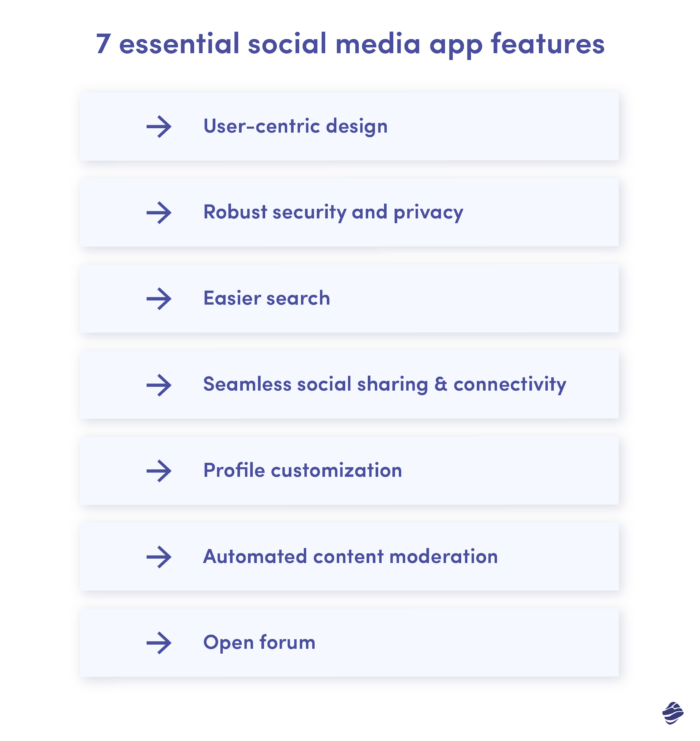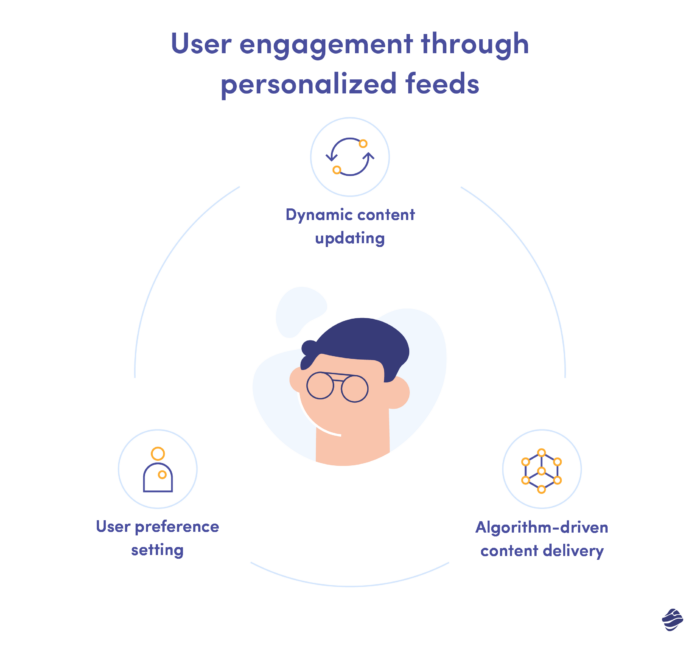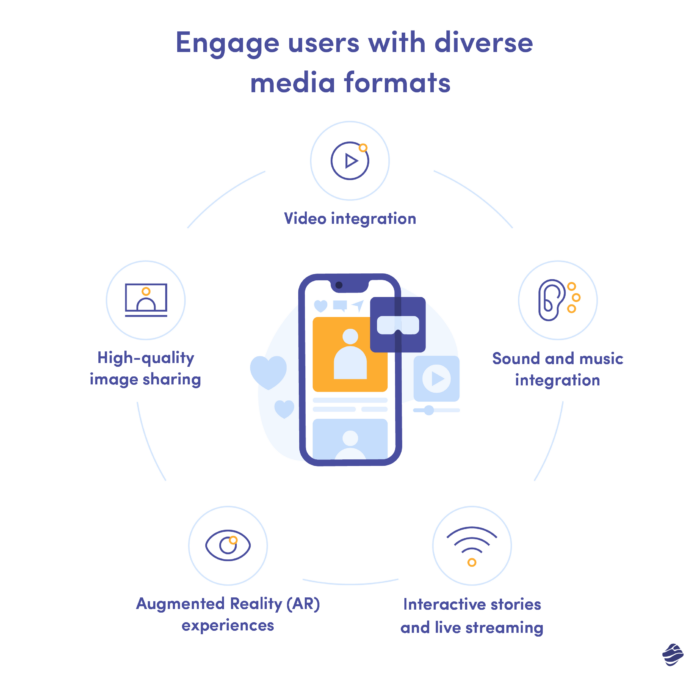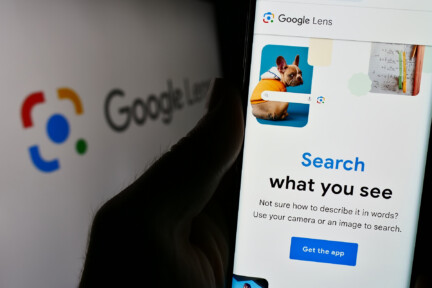In a world where over 4.89 billion people use social media – a number projected to soar to almost 6 billion by 2027 – staying ahead of the curve isn’t just a luxury; it’s a necessity. But what propels a social media app from good to extraordinary? It’s all in the features – those innovative, user-centric elements that convert an ordinary platform into an epicenter of engagement, creativity, and community. Surprised? There’s more to the story.
Here’s a sneak peek at what we’ll explore:
- Key Features of Successful Social Media Apps: What distinguishes the best?
- User Engagement Mechanics: Personalized feeds, push notifications, interactive content, and robust networking.
- AI and Machine Learning: Pioneering personalized content and advertising.
- Multimedia Capabilities: Driving user retention through diverse content.
- Social Commerce Functionalities: Merging e-commerce with advertising for revenue.
- User Analytics and Feedback: Strategic tools for decision-making and app enhancement.
- Future Trends: Innovations shaping the next era of social media apps.
P.S., speaking of pioneering the future, let’s shine a light on Miquido. With a team of over 200 passionate professionals, Miquido marries your business goals with the latest tech solutions. It’s more than social media and entertainment app development; it’s about crafting impactful digital experiences. Join us on this journey and see how Miquido’s expertise can skyrocket your digital strategy.
7 Key Social Media App Features
In the dynamic realm of social media, certain social media app features consistently elevate apps to success. Let’s delve deeper into these essential elements, starting with the cornerstone: user-centric design.

1. User-Centric Design
- Intuitive Interface: Leading social media apps, for instance, Instagram and TikTok, are prime examples of intuitive interfaces. They combine aesthetic appeal with practicality, featuring clean layouts, straightforward navigation, and a minimalist design philosophy. A study shows that 94% of first impressions are design-related, underscoring the importance of an interface that’s not just visually striking but also user-friendly from the get-go. This means new social media applications fail because of a poor design that’s not user-centered.
- Personalization: The era of generic content is over. Successful apps leverage algorithms and user data to offer tailored experiences. Think about how YouTube recommends videos based on your past views. These approaches enhance user engagement and boost content relevancy, keeping users hooked.
- Accessibility: Inclusivity is key. Top apps integrate features such as voice commands (as seen in WhatsApp), screen readers, and adjustable text sizes, catering to a diverse user base. This isn’t just about compliance; it’s about reaching a wider audience and ensuring that everyone can enjoy the app regardless of their abilities.
Pro Tip: Implement AI and Machine Learning
To make your new social media app stand out, consider implementing AI and machine learning for advanced personalization. Tools such as TensorFlow or IBM Watson can analyze user behavior to tailor content, thereby increasing engagement and user satisfaction.
Tool Suggestion: User Testing Platforms
Utilize user testing platforms such as Lyssna or UserTesting.com. These tools provide invaluable insights into how real users interact with your app, allowing you to refine the interface and user experience based on actual data and feedback.
Remember, a social media mobile app that’s intuitive and enjoyable is the best social media app that users will return to time and again.
2. Robust Security and Privacy
In an age where data breaches and privacy concerns are front and center, robust security and privacy features are non-negotiable for successful social media apps.
- End-to-end Encryption: Popular social media apps similar to WhatsApp and Signal have set the standard with end-to-end encryption, ensuring that user conversations remain private. This feature has become a benchmark for user trust and app credibility.
- Transparent Data Policies: Users are increasingly savvy about their data. Apps that clearly communicate how user data is used and protected, like LinkedIn, gain user trust. Transparency isn’t just ethical; it’s smart business.
- Regular Security Updates: Ongoing updates and patches, as practiced by Facebook, demonstrate a commitment to security. It’s not just about fixing vulnerabilities; it’s about staying ahead of potential threats.
Pro Tip: Regular Security Audits
Conducting regular security audits can be a game changer. Tools like Nessus or Qualys help identify vulnerabilities before they become problems, ensuring your social media mobile app remains a safe space for users.
Stat Alert: A recent survey revealed that 81% of consumers would stop using a social media platform following a data breach. This highlights the paramount importance of security in retaining user trust and loyalty.
3. Easier Search
In the vast ocean of social media content, easier and more efficient search functionality is a lifeline for users. It’s not just about finding what you’re looking for; it’s about discovering what you didn’t know you needed.
- Advanced Search Algorithms: Platforms such as Twitter and Pinterest have mastered this with their advanced search algorithms, enabling users to find specific content quickly and accurately. This feature is key to enhancing user experience and engagement.
- Search Filters and Tags: The ability to filter search results by various parameters (like date, location, or hashtags, as seen on Instagram) allows users to streamline their search process, making it more user-friendly and less time-consuming.
- Auto-Suggestions and Predictive Search: Take a cue from Facebook, where auto-suggestions based on previous searches and user activity make the search experience faster and more intuitive.
Pro Tip: Leverage Natural Language Processing (NLP)
Implementing Natural Language Processing (NLP) can significantly enhance your search feature. NLP allows the social media platform to understand and process user queries in a more human-like manner, offering more relevant and contextual results.
Tool Suggestion: Elasticsearch
Consider integrating tools such as Elasticsearch into your platform. Elasticsearch can handle complex search queries and offers fast, scalable search capabilities, making it an invaluable asset for any social media app.
4. Seamless Social Sharing and Connectivity
In the interconnected world of social media, seamless sharing and connectivity features are vital. They’re the threads that weave the social fabric together, turning individual experiences into collective moments.
- Effortless Sharing Options: Apps like Instagram and Twitter excel in this, offering straightforward sharing functionalities. Whether it’s reposting a story or tweeting a link, the ability to share content across platforms with a few taps is key to user engagement and content virality.
- Cross-Platform Compatibility: The power to share content not just within the social app but across different platforms (like sharing Instagram posts to Facebook) broadens the reach and impact of content, making it more accessible to a wider audience.
- Real-Time Interaction Features: Social media app features such as live streaming on Facebook and real-time commenting on YouTube amplify user interaction, fostering a sense of community and immediacy.
Pro Tip: Integrate Share APIs
To enhance sharing capabilities, integrate share APIs from various social media platforms. This not only simplifies content sharing but also ensures that your social app stays connected with other major platforms, increasing its utility and appeal.
5. Profile Customization to Express Individuality
Profile customization is more than a feature; it’s a canvas for self-expression. In today’s social media landscape, giving social media app users the ability to personalize their profiles is a game-changer. It’s about making a space feel uniquely theirs.
- Diverse Customization Options: Facebook and LinkedIn offer a range of customization features, from profile pictures and cover photos to bio sections and featured content. These options allow users to create a personal digital identity that reflects their individuality.
- Theme and Layout Choices: Apps, for example, Tumblr take customization further by allowing users to alter themes and layouts. This level of personalization makes each user’s experience distinct and engaging.
- Interactive and Dynamic Elements: Incorporating interactive elements like story highlights on Instagram or custom playlists on Spotify adds another layer to profile customization, making it more dynamic and reflective of the user’s current interests.
Pro Tip: User-Centric Design Tools
Incorporate user-centric design tools in your app, like drag-and-drop interfaces for profile customization. This empowers users to create their unique space effortlessly, enhancing their attachment to the app.
Tool Suggestion: Advanced UI Libraries
Use advanced UI libraries and SDKs that offer a wide range of design elements and customization options. These tools become the best mobile app retention strategies that can significantly simplify the development process while providing users with extensive customization capabilities.
Statistic to Consider: A survey revealed that 77% of users feel more connected to a social media app when they can personalize their profiles, underscoring the importance of customization in user retention and satisfaction.
6. Automated Content Moderation
In the digital age, where content is king, automated content moderation stands as the gatekeeper of online safety and community standards. This feature is crucial in fostering a respectful and secure environment for users.
- AI-Driven Moderation Systems: YouTube and Facebook use sophisticated AI algorithms for content moderation. These systems can quickly identify and flag inappropriate or harmful content, ensuring a safer online space for users.
- User Reporting and Feedback Loops: In addition to AI, empowering users to report content violations, as seen on Reddit, plays a pivotal role in content moderation. This user involvement creates a sense of community responsibility and enhances the effectiveness of moderation efforts.
- Regular Policy Updates: The digital landscape is constantly evolving, and so are the challenges of content moderation. Regularly updating community guidelines and moderation policies, as Twitter does, ensures that the platform remains a safe space for expression and interaction.
Pro Tip: Implement a Hybrid Moderation Approach
Combining AI with human oversight can significantly improve content moderation. While AI provides scalability and speed, human moderators offer nuanced understanding and judgment, leading to more effective and accurate moderation.
Tool Suggestion: Content Moderation Solutions
Consider using content moderation solutions like Microsoft Content Moderator or Clarifai. These tools provide powerful AI capabilities for detecting and filtering inappropriate content, while also offering customization options to align with your platform’s specific needs.
By integrating automated content moderation into your social media app, you’re not just curating content; you’re cultivating a safe and respectful digital ecosystem. This not only protects users but also enhances the overall quality and credibility of the platform.
7. Open Forum to Foster Community and Dialogue
The feature of an open forum in social media apps is like a digital town hall – it’s where conversations flourish and communities are built. In today’s social landscape, providing a space for open dialogue is essential for fostering a sense of belonging and exchange.
- Discussion Threads and Comment Sections: Reddit and Twitter excel in this, offering structured spaces for discussion threads and comment sections. This format encourages active participation and exchange of ideas among users.
- User-Generated Content Spaces: Encouraging user-generated content, as seen on platforms like Instagram and TikTok, allows users to not only express themselves but also engage with the community through likes, shares, and comments.
- Moderated Discussions for Quality Control: While open forums are valuable, quality control is crucial. Implementing moderation, like LinkedIn’s professional community standards, ensures discussions remain constructive and respectful.
Pro Tip: Implement AI for Sentiment Analysis
Using AI-driven sentiment analysis tools can help monitor the tone and quality of discussions in your open forum. This technology can flag potentially harmful or off-topic content, maintaining a healthy and engaging dialogue.
Tool Suggestion: Community Management Platforms
Consider integrating community management platforms like Discourse or Vanilla Forums. These tools offer robust features for managing and moderating forums, enhancing the user experience and fostering a vibrant community.
Miquido’s Vision: As a mobile app development company, we understand the power of community. Our approach includes creating and managing open forums that not only allow for free expression but also maintain a respectful and engaging discourse. Let’s collaborate to develop an app that’s more than a platform – it’s a community.
User Engagement Mechanics to Drive Active Participation
User engagement mechanics are the heartbeat of social media apps. They’re what keep users not just coming back, but actively participating. Let’s explore the first of several critical engagement mechanisms.
Personalized Feeds
- Algorithm-Driven Content Delivery: Apps such as Facebook and Instagram use sophisticated algorithms to curate personalized feeds. These algorithms analyze user interactions (likes, shares, comments) to present content that’s likely to keep users engaged and interested.
- Dynamic Content Updating: Ensuring that the feed remains fresh and relevant is key. Successful apps frequently update content, avoiding redundancy and keeping users intrigued with new posts and suggestions.
- User Preference Settings: Allowing users to tailor their feed settings, as seen on X (formerly Twitter), gives them control over what they see. This enhances their experience by aligning the content with their interests and preferences.

Pro Tip: Balance is Key
Finding the right balance in content curation is crucial. Over-personalization can lead to echo chambers, while too little can make the feed irrelevant. Regularly updating algorithms and offering user feedback options can help maintain this balance.
By focusing on personalized feeds, you’re not just showing users content; you’re showing them content that resonates. This not only keeps them engaged but also deepens their connection to the app.
AI and Machine Learning to Revolutionize User Experience
Harnessing the power of AI and Machine Learning (ML) is transforming how social media apps engage with users. This technology is not just a feature; it’s a catalyst for creating smarter, more intuitive user experiences.
Revolutionizing Content and Advertising with AI
- Content Personalization: AI algorithms, like those used by Netflix, analyze user behavior to recommend content. This level of personalization keeps the platform relevant and engaging for each individual user.
- Targeted Advertising: AI-driven advertising, as seen on social networking sites like Instagram, delivers ads that are relevant to the user’s interests and online behavior, enhancing the likelihood of user engagement and conversion.
- Smart Chatbots: AI-powered chatbots, utilized by apps such as Slack, provide instant customer support and user interaction, enriching the overall user experience.
Enhancing User Experience with Machine Learning
- Automated Content Curation: ML algorithms can categorize and prioritize content based on user preferences, similar to YouTube’s video recommendations, ensuring users are presented with content that resonates with their interests.
- Behavioral Analysis for Improved Interactions: By analyzing user data, ML can predict user preferences and tendencies, tailoring the app experience to suit individual needs.
- Language Processing for Global Reach: Advanced ML models enable apps to understand and process multiple languages, breaking down barriers in user communication and content consumption.
Multimedia Features of a Social Media App to Enrich User Engagement
The integration of multimedia capabilities in social media apps has revolutionized the way users interact and consume content. Let’s dive into how these best social media features enhance the user experience.
Elevate Interaction with Diverse Media Formats
- Video Integration: Following the lead of platforms like TikTok and YouTube, incorporating video features is vital. These allow users to create, share, and engage with dynamic content, keeping the platform lively and current.
- High-Quality Image Sharing: Instagram emphasizes high-quality image sharing, enabling users to upload and interact with visually stunning content, fostering a visually rich user experience.
- Interactive Stories and Live Streaming: Snapchat’s Stories and Facebook Live introduce real-time engagement, allowing users to share moments instantly and interact with audiences in real time.

Maximize User Retention through Engaging Content
- Augmented Reality (AR) Experiences: AR features, such as Instagram’s filters, offer unique, interactive experiences, adding a layer of creativity and fun to the user experience.
- Sound and Music Integration: Spotify and TikTok show the importance of integrating sound and music, giving users a more immersive and expressive way to share and engage.i
At Miquido, we understand the power of multimedia in captivating audiences. Our team specializes in integrating diverse media formats, from AR to high-fidelity audio, ensuring your app provides a rich, engaging, and memorable user experience. Partner with us to get custom app development services and create an app that’s not just a platform, but a multimedia powerhouse.
Social Commerce Functionalities to Monetize Engagement
Social commerce is not just a feature; it’s a revolution in how users interact with and purchase products on social media platforms. Let’s enhance our understanding with deeper insights and actionable strategies.
Transforming Browsing into Buying For A Seamless Experience
- Integrating E-Commerce: Instagram and Pinterest have seamlessly integrated e-commerce, transforming passive scrolling into active shopping. Users can now discover products through influencer endorsements, targeted ads, and direct shopping features within their social feeds.
- The Role of Influencers: Influencers play a crucial role in social commerce. Their endorsements can dramatically boost product visibility and credibility, as seen with the success of brand partnerships on platforms like TikTok.
- Streamlined Shopping: The integration of features like Instagram’s ‘Shop Now’ buttons simplifies the purchasing process, allowing users to buy products without leaving the app. This not only enhances user convenience but also increases the likelihood of impulse purchases.
Utilize user data to create targeted advertising campaigns. By analyzing user behavior and preferences, a mobile app developer can tailor ads to match user interests, significantly increasing conversion rates.
Consider using platforms such as Shopify or BigCommerce to integrate e-commerce functionalities into your app. These tools offer robust solutions for managing product listings, payments, and customer interactions, streamlining the shopping experience.
A recent survey revealed that 30% of online shoppers are likely to make a purchase directly through social media platforms, highlighting the growing importance of social commerce in the digital marketplace.
Driving Revenue through User Interaction
The integration of direct purchase options has opened new avenues for monetization. In-app shopping features, exemplified by Facebook Marketplace, not only streamline the buying process but also keep users engaged on the platform, turning browsing time into buying time.
User Analytics and Feedback Are Key to Continuous Improvement
In the ever-evolving world of social media, user analytics, and feedback are invaluable for understanding and enhancing the user experience. This data-driven approach helps in making informed decisions that align with user needs and preferences.
Understand User Behavior through Analytics
- Tracking Engagement Metrics: Google Analytics helps in tracking user engagement metrics such as time spent on the app, frequency of visits, and interaction rates. This data provides insights into user behavior, guiding improvements, and feature updates.
- Segmentation for Targeted Strategies: Segmenting users based on their behavior and preferences allows for more targeted and effective strategies. This can lead to more personalized experiences, as seen in apps like Spotify, where listening habits influence recommended playlists.
- A/B Testing for Optimized Features: Utilizing A/B testing tools like Optimizely helps in understanding what features or changes resonate best with the audience, ensuring that updates are user-centric and impactful.
Leverage Feedback for Growth
- Incorporating User Surveys: Direct feedback through user surveys can reveal what users love and what they want improved. This direct line of communication, as used by apps like Duolingo, is crucial for user satisfaction and retention.
- Community Forums for Collaborative Development: Platforms such as Discord use community forums to gather user feedback, fostering a collaborative environment where users feel heard and valued.
- Proactive Response to Feedback: Actively responding to user reviews and feedback, not just collecting it, is vital. This shows users that their opinions matter, building loyalty and trust.
Future Trends That Will Shape the Next Era of Social Media
As we look to the horizon of social media, emerging trends in mobile app development are set to redefine how we interact, share, and connect online. Here are some key trends that are shaping the future of features of social media app:
- Augmented Reality (AR) Experiences: AR is transforming user interactions, offering immersive experiences that blend the real and virtual worlds. Apps, for instance, Snapchat are leading the way, but soon, more platforms will integrate AR for interactive content and advertising.
- Voice and Conversational Interfaces: The rise of voice-activated assistants and chatbots signifies a shift towards more natural, conversational user experiences. Expect to see social media apps integrating voice commands and chat interfaces for easier, more intuitive interactions.
- AI-Powered Content Creation: AI isn’t just for content curation; it’s moving towards content creation. With tools such as OpenAI’s GPT models, future social media platforms may offer AI-generated content, tailored to individual user preferences.
- Privacy-First Networking: In response to growing data privacy concerns, a new wave of social media networks focusing on privacy and security is emerging. These apps will prioritize user consent and data protection for a protected social media presence, appealing to privacy-conscious users.
- Virtual Reality (VR) Social Spaces: Following the footsteps of platforms similar to VRChat, social media will increasingly venture into VR, offering fully immersive virtual environments for users to interact and engage in.
- Blockchain and Decentralized Social Media: Blockchain technology promises a new era of decentralized social media, where users have more control over their data and content. This trend could lead to more transparent, secure, and user-centric social platforms.
- Eco-conscious Platforms: With a growing emphasis on sustainability, future social media apps may focus on eco-friendly practices, from reducing digital carbon footprints to promoting environmental awareness among users.
To further discover current industry trends, download this FREE Social Mobile Apps Report.
Stay Ahead in Features of A Social Media App with Miquido
As we’ve journeyed through the dynamic landscape of social media app features, it’s clear that staying ahead of the curve is about embracing innovation and user-centric design. You’re now armed with insights to navigate this exciting terrain successfully.
Let’s recap on features of a social media app:
- User-Centric Design: The core of a successful app.
- Robust Security: Essential for trust and loyalty.
- Efficient Search Features: For a seamless user experience.
- Seamless Social Sharing: Fosters community and connectivity.
- Profile Customization: Enables personal expression.
- Automated Content Moderation: Maintains a safe online space.
- Open Forum Features: Encourages community dialogue.
- Engaging User Mechanics: Keeps the audience captivated.
- AI and Machine Learning: Drives innovation and personalization.
- Multimedia Capabilities: Enriches user engagement.
- Social Commerce Functionalities: Opens new revenue streams.
- User Analytics and Feedback: Guides improvement and growth.
- Future Trends: Prepares for the next digital wave of social media app development.
Now that you’re equipped with the knowledge of what makes a social media app truly exceptional, it’s time to turn these insights into reality. And who better to partner with than Miquido? Our expertise in developing cutting-edge social media apps ensures that your platform is not just a part of the trend but ahead of it. Let Miquido be your guide in this ever-evolving digital journey, where innovation meets practicality.









